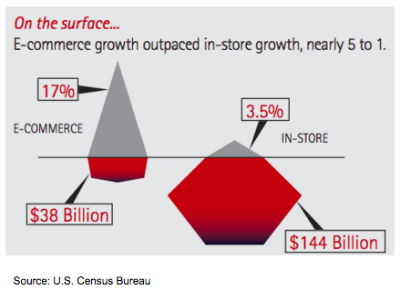In 2015, E-commerce growth outpaced in-store growth by nearly 5 to 1. In the US, Black Friday sales decreased by 11.9% compared to 2014. The forecast is looking gloomy for physical retailers but is this really the case? What is shopability and how do you achieve it? And why is it that some stores are more shopable than others in times of crisis? We’re here to quickly examine four main excuses retailers still make to not reach shopability.
E-commerce Growth is Diminishing the Brick-and-Mortar Retailer.
Yes, retailers are facing a steady decline in in-store traffic and growth is being squeezed by online merchants. But the truth is, although e-commerce growth outpaced in-store by nearly 5 to 1, the 17% only represents $38 billion while the 3.5% growth equates to a whopping $144 billion. And remember 94% of total retail sales are still generated in brick & mortar stores. Basically, brick & mortar retailers are still chewing up most of the pie.

In-store Traffic is at an ALL TIME LOW.
Rather than focusing on the decreased traffic flow, retailers should focus on how can they improve shopability. Shopability is to stores what usability is to webpages. In a shopable store, sales staff ratio are optimal with a store experience that is designed to drive bottom-line conversion. An improvement in conversion by several points will more than balance out the missed opportunity sales from decreased traffic. Now below the surface of conversion, we found that there are two underlying behavioural factors that contribute to it: shopper time and coverage. By using sensor technologies on the market, some retailers are measuring these KPIs to a/b test different in-store seasonal campaigns and visual merchandising. For example, some retailers use facial recognition technologies to detect the capture rate of the window merchandising and a/b test different designs to scale across other stores. Through these methods retailers are able to personalise the experience of the shoppers and improve shopability. By focusing on shopability, retailers achieve higher profitability with greater retention.
"Shopability is to stores what usability is to webpages."
There is a Large Gap in Offline Customer Journey Information.
Most retailers currently only rely on people counters to track the inflow and outflow of visitors inside the store and point-of-sale (POS) systems at the cash register. This is similar to an e-commerce shop measuring the number of unique visitors on the homepage and the checkout page but not the conversion funnel. In the brick-and-mortar retail space, we’re gradually seeing a trend towards retailers adopting a data-driven approach through the use of in-store retail analytics. How many females reached the third floor? During what time of the day is there a congestion at the queue? Where are the low and high activity zones on the floor? By empowering such technologies, retailers are uncovering behavioural insights about each segment of their visitors. And all of this data mining is leveraged to strengthen the core advantage against online retailers, the shopping experience.
It is Difficult to Distinguish an Online Sale from an Offline one.
Attribution in this multi-channel climate is becoming increasingly difficult to achieve. Shoppers now have an abundance of resources to check for the best quality, price and merchants. A behavioural side effect to these conditions being a phenomenon called showrooming, which is the process of a shopper visiting a store to examine a product with the intent to purchase it online for a cheaper price. To combat showrooming, some retailers are doubling down by leveraging customer behaviours in-store and measuring the engagement levels of items to cross-reference with the sales data. If the SKU has high engagement and low sales, this is a strong indication of a high showrooming item and a price-cut would be advised. By combining behavioural insights with the sales data, retailers reach a third layer of insight towards attribution. Additionally there are other strategies of using customer loyalty programs, superior customer service and other value drivers that just cannot be matched online.
As for the forecast, there is nothing a retailer can do to change that. However there are many technologies on the market that can make the retailer more responsive and intelligent in how they react to the storm. By honing the advantages of the shopper experience and leveraging behavioural insights, we have a positive outlook on retailers to become more shopable.